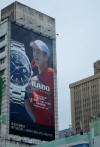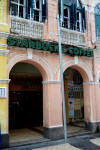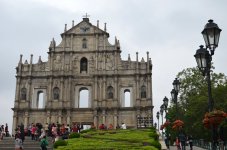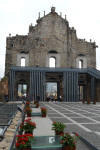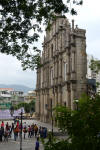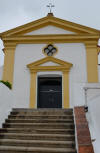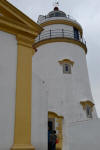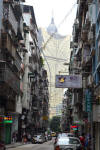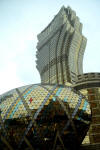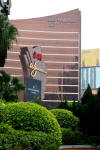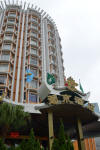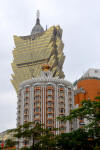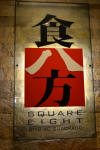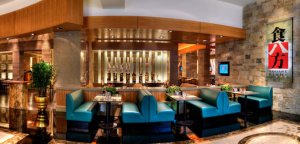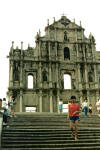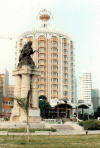Round The World and other travels
A frequent flyer's collection of trip diaries
This is: The Portuguese Connection (2012)
Historic Macau - walking in my own footprints
The hotel had been good enough to grant us complimentary breakfast at check-in and our first opportunity to make use of the perk proved to be an amazingly quiet affair, perhaps partly explained by the fact that we had got up nice and early. The restaurant had put out an extensive and appealing spread, and there was an egg station manned by one of the chefs.
We quickly got ourselves organised, ordered a cab and asked the driver to take us to the Ruins of St Paul's. The journey in broad daylight once again pressed home the scale of the changes to the Macau that I had seen in 1986. The once-separate islands of Taipa and Coloane had been merged as a result of land reclamation. Similarly, the main peninsula had grown outwards into the sea, so that the triangular arch on the Ponte Governador Nobre de Carvalho (the original Macau-Taipa bridge, now in the company of several others) was no longer in the middle of the water. And most notably of all, my memories of a semi-rural backwater were now being superseded by a bustling cityscape filled with tall buildings and a plethora of Las Vegas-style casinos.
 |
 |
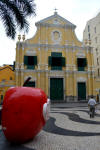 |
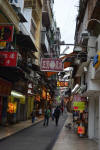 |
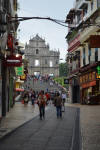 |
LEFT: From Senate Square to the Ruins of St Paul's, including the Holy House of Mercy and St Dominic's Church |
 |
 |
BELOW and BELOW LEFT: Look who's here! |
Overlooking the Ruins of St Paul's is the Fortaleza do Monte (Mount Fortress), built by the Jesuits and once Macau's principal defence structure, largely responsible for successfully repelling an attempted Dutch invasion in 1622.
| RIGHT: The Mount Fortress, which towers above the Ruins of St Paul's, was originally the city's main defence structure. The site is also home to the Macau Museum. |
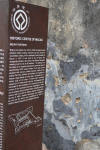 |
 |
 |
 |
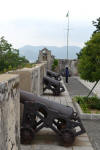 |
 |
 |
 |
After taking time to look around the fortress, admire the panoramic views and recover from the climb, we set off downhill through some back streets where the housing density was such that everyone would need to get along really well with their neighbours! Our next objective was St Michael's Catholic Cemetery. It isn't easy to describe why a burial place should also be an attraction: the colourful little chapel, well-tended grounds, lavish monuments and mix of Chinese and Portuguese cultures all played a part in the overall experience.
 |
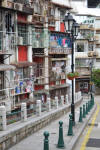 |
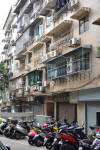 |
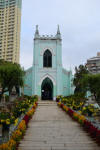 |
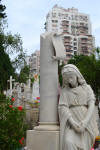 |
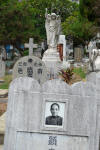 |
 |
|||||
| ABOVE: Heading back downhill towards St Michael's Catholic Cemetery | |||||
Just downhill from the cemetery we arrived at Tap
Seac Square, resplendent with beautifully painted neo-classical
buildings. It is also home to a sports pavilion, and outside this
the Grand Prix was being shown on a huge public TV screen. The noise
from this event had been getting ever more intrusive as the morning
progressed, but it hadn't caused us any great inconvenience so far.
Bruce happened to notice that one of the buildings, the Tap Seac
Gallery, was hosting a photography exhibition called Exposure!.
Featuring the work of London-based photographer Clive Barda, the
theme of the exhibition was classical music and the performing arts.
Given my own main interest outside the world of travel, this was an
extraordinary find - one of those delightful, unplanned events that
turns out to be a highlight of the day.
![]()
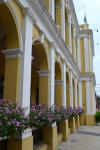 |
 |
 |
 |
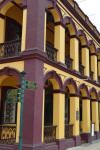 |
 |
 |
 |
 |
 |
||
| ABOVE: Tap Seac Square, with the Grand Prix on TV and the gallery hosting the exhibition 'Exposure!' | |||||
Although we had already covered a great deal of historic Macau without much of a break, we still had some way to go before having lunch! A short distance from Tap Seac Square, we caught the little cable car to Guia Hill.
Finally, it was time to start heading downhill into the part of the Macau peninsula that has become home to a number of casinos.
Having packed such a huge amount into the morning and now feeling thoroughly satisfied by our late lunch, we decided to call it a day and take a cab back to the Westin. We had a good look around the property and couldn't help noticing that defects such as peeling paint were rather more prominent in the daylight. It seemed extraordinary that absolutely nobody - including ourselves, admittedly - had any inclination to use the pool or the other leisure facilities.
When the time came, we once again ended the day with a room service dinner.
Friday 16 Nov
_____________________
1986 visit
I decided to dig out some of my 1986 photos of Macau to confirm the scale of the changes that had taken place in the period since my one previous visit. They did indeed help to verify that my memory wasn't playing tricks on me!
The final photo looks suspiciously like Hac Sa Bay, the location of the Westin. As such, it gave me a strange feeling when I saw it again.
